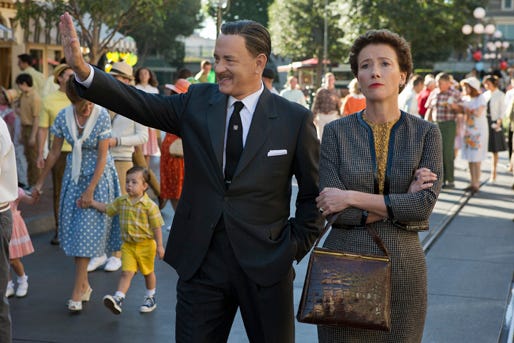Saving Mr. Banks

When it comes down to facts, "Saving Mr. Banks" might be nothing more than candy-colored hooey. It depicts the battle between author P.L. Travers and entertainment entrepreneur Walt Disney as they clashed on how to best adapt "Mary Poppins," her beloved children's novel, for the big screen.
Did Travers really toss a script onto the studio lawn in disgust? Did her icy demeanor briefly thaw as the Sherman brothers first sang “Let’s Go Fly a Kite”? Was the deal sealed only after Disney caught an impromptu red-eye flight to Britain?
Maybe. Maybe not. Doesn’t matter. No need for suspense here. Spoiler alert: They made a “Mary Poppins” movie. Perhaps you’ve seen it. Instead, “Banks” delves into more introspective, and interesting, details of how the film was finished, namely how Travers and Disney navigated a particularly thorny bramble of collaboration. Even if that’s also speculative, it’s where “Banks” finds all the authenticity it needs to work — depicting tumultuous emotions that inspire, and torture, creative types.
What hopeful lies are spun in fiction to dull the pain of real life? Can an author give a cipher salvation that eluded the person who inspired him? And can any creator ever really escape long shadows cast by a work intended as a monument to a loved one?
“Banks” could’ve been two obnoxiously twee hours of a studio patting itself on the back to celebrate smooth-talking commerce’s triumph over spiky-tongued art. And it's still very much a lighthearted, vibrant film that will work for the large audience at whom it's aimed.
But it lets these thoughtful, complex questions about creativity propel its portrayal of the larger-than-life icons at its core, with help from Kelly Marcel and Sue Smith’s charming, perceptive script, sensitive direction by John Lee Hancock (thankfully working less in the schmaltzy milieu of “The Blind Side” and more in that of his masterful "The Rookie") and some finely calibrated performances by Emma Thompson as Travers and Tom Hanks as Disney.
The film’s major flaw is that its many strengths arrive much too late to save the first act.
For two decades, Travers has resisted Disney’s entreaties to turn over the film rights to her bestseller about the nice flying nanny. His persistence, he says, comes from a promise to his children, long since grown up.
But by 1961, Travers has reached her financial limitations. In need of money if she’s to keep her house, she flies to Hollywood to take meetings with Disney and his creative team: screenwriter Don DaGradi (Bradley Whitford) and Richard & Robert Sherman (Jason Schwartzman and B.J. Novak), a sibling pair of composers/lyricists. At the airport, she’s picked up by Ralph (Paul Giamatti), a chatty chauffeur who embraces a challenge to pry loose her stiff upper lip for meaningful conversation.
Each of these actors is a delight in juicy character roles, but none more so than Giamatti. In one of the movie’s greatest scenes, he reveals that his daily observation of the weather is not just idle chitchat but a way to rectify a fear in his life — much as, we learn, Travers did with her novel.
As for Travers, Thompson initially plays her as an unrelenting shrew so oblivious to even the most cursory social graces that she seems as fictitious as Mary Poppins herself. Only at the absolute make-or-break point of losing the audience, and the movie, does Thompson expand this shrill, sole dimension to believably flesh out the motives behind Travers' feisty self-reliance. It helps that we realize the big dream she's packed within this thin book.
Before she’ll turn over any rights, Travers demands script approval. To Disney, DaGradi and the Shermans, her demands seem endlessly frustrating and finicky — forbidding animation, dictating production design, badmouthing the tongue-twisting “Supercalifragilisticexpialidocious.” (Hearing the Shermans’ timeless songs in workshop status is among the film’s many inside-baseball pleasures.)
But none knows of her deep-seated obligation to protect the essence of “Mary Poppins” or her unspoken resentment of Disney — both rooted in her childhood.
In flashbacks, we see Travers as a young girl — on an itinerant trek across Australia with a father (Colin Farrell) adept at inspiring creativity in his daughters but incapable of keeping a job or his sobriety. As a man with senses dulled by woven fantasy and swallowed whiskey, Farrell finely balances whimsy and depression.
Subtle is the suggestion that Travers sees in Disney a man who forged an empire on the very fancifulness that doomed her family to economic and emotional hardship. Perhaps it’s why she takes such pride in being an immovable object to his irresistible force. Thompson and Hanks bring lively, old-pro zest and zeal to every clash — circling each other like conversational predators, each one waiting for the other’s guard to drop.
What Hanks lacks in a physical resemblance to Disney, he makes up for with full inhabitance of the mogul’s childlike wonderment, locked-in conversational concentration and guarded optimism. He’s a gregarious man, yes, but he also takes silent-but-visible offense to Travers’ characterization of Mickey Mouse as a “cartoon.” Is Mickey not to him as Mary is to her? The script suggests the hint of a storm in Disney’s artistic soul, too.
But it also remembers that, at the end of the day, Disney was a savvy businessman — particularly in a climactic monologue that’s an elegant mission statement, an unmannered confession and a well-worn sales pitch rolled into one. Honest as Disney is here, he’s trying to protect his investment. And given the film’s shrewd consideration of the public personae Travers and Disney so carefully calculated, a postscript at the film’s premiere isn’t so easily read as a feel-good reconciliation of their respective goals.
Ultimately, “Banks” is every bit the charming confection you expect it might be, but it’s also uncommonly and unexpectedly thoughtful about the troubles of the creative mind and the travails of the creative process. Consider them the spoonfuls of salt that make this medicine go down.


